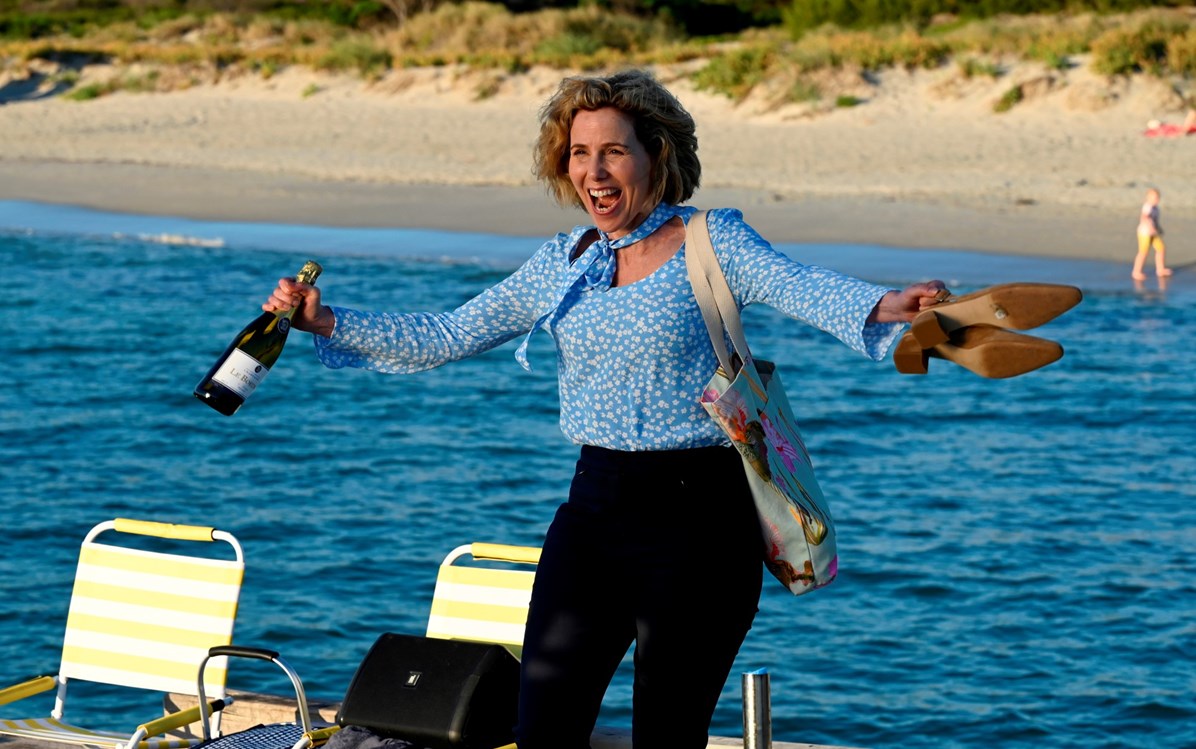Help keep The Curb independent by joining our Patreon.
First time feature writer-director Renée Webster has crafted something of a miracle with the utterly hilarious and delightful How to Please a Woman. Building on her exceptional work with TV series The Heights and Itch, Webster emerges here as a fully formed filmmaker with something to say, and intends to do so through pure entertainment and ultimate hilarity.
Filmed in little old Fremantle, WA, How to Please a Woman follows Gina (the utterly charming Sally Phillips), an office worker who finds her life heading towards a rut as she’s swiftly booted out of her job, all while she’s working to reignite a romantic spark in her loveless marriage with Adrian (a rugged Cameron Daddo). Noticing an opportunity like no other, Gina swoops in to revive a flailing removal company run by Steve (the suave and debonair Erik Thomson), hoping to turn it into an all-male housecleaning business. After her friends chip in and get a male stripper (Tom – Alexander England once again reminding he is one of the finest comedic actors working in Australia today) for her birthday, Gina becomes disgruntled, making him clean her house instead. Afterwards, through deep discussions with her friends about Gina’s need for physical affection, she comes to realise that there is a grander opportunity at play for the business, one that involves the seemingly untapped field of male sex work.
Turning the four removalists into sex workers is no easy feat, with Ryan Johnson’s self-confident Anthony and Josh Thomson as Ben joining Steve and Tom all working to find their own feet in their surprising new vocation. Steve instantly opts for the office worker role, citing being married as a reason for disengaging with bedroom activities. For Tom, he has no quibbles in that department, but instead flounders when it comes to the actual cleaning of the house, leaving it almost as messy as when he arrived. Ryan Johnson provides one of the best early laughs as a sexual novice turned jackhammer who fails to realise that he is there to satisfy the paying client, and not just get himself off. If there’s a minor complaint about the film, it’s that the charismatic Josh Thomson is drastically underutilised as Ben, even if he is given a devastatingly comedic third act scene. As a troupe of gents facing unemployment, their willingness to thrust themselves into a difficult new career path is entertaining and enlightening, and ultimately leads to the important reminder that male sex work is a field that is as necessary and patronised as that of their female counterparts.
Great Aussie comedies often feel like miracles. Our film industry has, at times, become so risk averse that when presented with a narrative that might push buttons or boundaries, it often feels like filmmakers are requested by the purse-holders to pull back, possibly aiming for a more ‘audience friendly’ approach. While this is a sweeping statement (after all, The Little Death exists), the wealth of dramas that make up a sizable chunk of the Aussie film industry can make a film like How to Please a Woman feel like a refreshing anomaly in the growing cinematic landscape. Not just for Australian cinema, but for global cinema as a whole.
Renée Webster’s biting and empathetic script manages to find humanity within humour, as she navigates sexual desire, ageing, queer awakenings, romance, and the pure sensation of being listened to and understood, amidst a grounded narrative that gives screen veterans like Tasma Walton, Roz Hammond, Hayley McElhinney, Nina Young, Caroline Brazier and co the chance to embrace the informed, lived-in experience of wanting to be romanced, respected, and sexually satisfied: you know, treated like a real human being. The communal support each woman has for one another strengthens the role that friendship has in their lives, creating sounding boards for their daily issues. It’s this space for nonjudgmental discussion that provides the freedom to discuss the sexual inadequacies within their lives, and most importantly, the craving for no strings attached sexual satisfaction.
This nonjudgmental vibe carries across in the post-swim sessions at the stunning Leighton beach, where bodies of all shapes and sizes are presented without judgment, eroticisation, or titillation in the change rooms. Echoes of Sarah Polley’s masterpiece, Take This Waltz, (another film about life renewal and exploring desires, sexual and otherwise), ring through the air here, reminding us of the importance of removing the male gaze from films, and allowing an unhampered female gaze approach to filmmaking.
That notion of renewal and discovery is integral to the plot, with each swim feeling like another step in an awakening for Gina and her friends. Having the space to be free from societal expectations allows Gina to grow in a way that will likely hit home for many audience members. Sally Phillips comfortably balances this journey with ease, moving from the stereotypical role of housewife who does all the cooking and cleaning to independent woman who runs her own business. It never feels forced or trope-ish, instead feeling like there is a genuine awakening within Phillips herself that’s taking place alongside Gina’s journey.
As Gina manages the burgeoning business, she takes to the carpark of Leighton beach as her makeshift office, turning her car into a pseudo-confessional where women of all ages outline their requests and desires. This is yet another moment where Webster’s script simply soars, with some truly emotional moments as the sexual desires of women are laid bare. One characters late-age realisation that they are bisexual is particularly emotional, working as a reminder that ones recognition of their queer identity can come at any moment in their lives. Another character talks about the physical attention she receives from her partners, and how difficult she finds it to discuss with them what she actually wants in bed; this moment in particular stands amongst the many as a pertinent reminder to partners of all genders that listening and understanding your partner’s body is key to a good relationship.
As a supporting character, Hayley McElhinney’s Hayley manages to reinforce the way we can listen to our partners bodies in a tender and beautiful performance that helps amplify Gina’s emotional journey. In an educational moment, Hayley teaches Anthony how to slow down, be considerate, and listen to the body of the woman he is there for. Ryan Johnson matches McElhinney perfectly here, with the growing realisation and dawning understanding that his porn-informed understanding of sex has lead him to become a self-servicing sexual partner, and that being a harmonious sexual partner makes for a more satisfying and enjoyable sexual experience. Hayley’s educational and supportive thread is given a welcome uplift in the second act as her own queer identity comes into the fold, once again reminding the beauty of presenting queer relationships on screen.
While there is humour in these moments, the laughter comes from the moment itself, not from the act of sex, or the sexual inadequacies of characters. Webster’s direction and writing consistently ensures that no persons sexuality, sexual prowess, or physicality is made the punchline of a joke, instead allowing the humanity to provide the laughs. It’s a difficult thread to weave, but one that’s made all the more easier with the light and carefree editing from Merlin Eden. A sequence between Gina, Steve, an exercise bike, and a croissant, instantly transforms into one an all-time great comedic scene that is made all the more enjoyable when surrounded by a receptive and full audience.
The impact of the Screen Australia Gender Matters is clear and evident on screen here, allowing How to Please a Woman to emerge as an instant Aussie comedy classic, with the exciting arrival of Renée Webster’s creative voice here to shake-up an industry dominated by male voices. This is a rare film that makes you feel lighter, fresher, and fully revitalised after watching it. It’s the kind of film that you want to spend hours talking with your friends about, reminiscing about how you could relate to what you’ve just seen. To say I fell in love with How to Please a Woman feels like an understatement, this is a film that I cannot wait to champion for years to come.
It is, quite simply, a breath of fresh air, a welcome torrent of laughter and joy after years of darkness and despair.
At its rapturous close, with a final, renewing jump into the ocean, the reminder that due to the pandemic we’ve been living through, we’ve been physically forced apart from loved ones, sexual or otherwise, for so long that when we can finally touch them once again, we want to do so in the most tender, supportive, caring, and physically satisfying way.
Director: Renée Webster
Cast: Sally Phillips, Erik Thomson, Hayley McElhinney
Writer: Renée Webster
Producers: Tania Chambers, Judi Levine
Cinematography: Ben Nott
Editing: Merlin Eden




